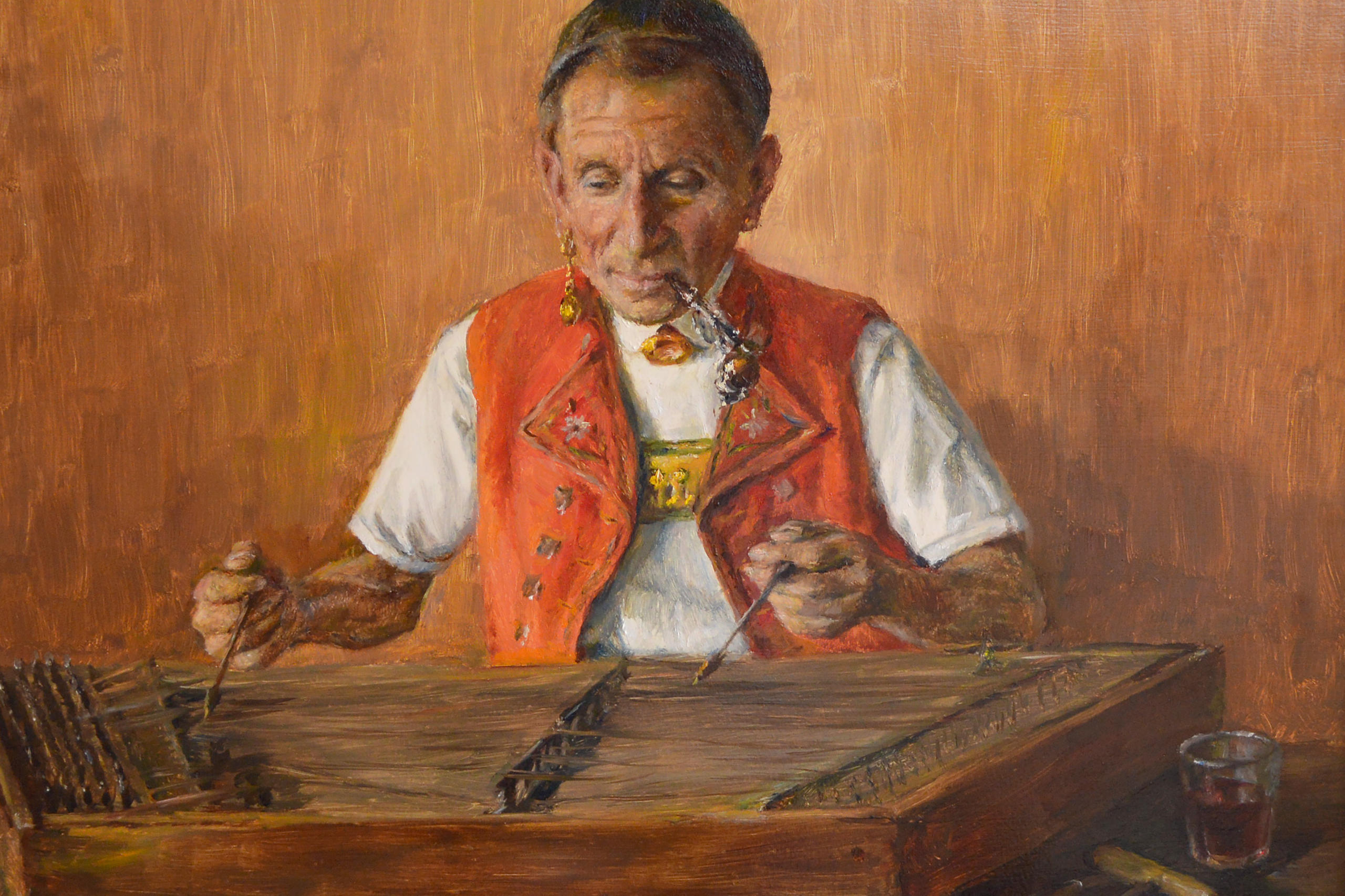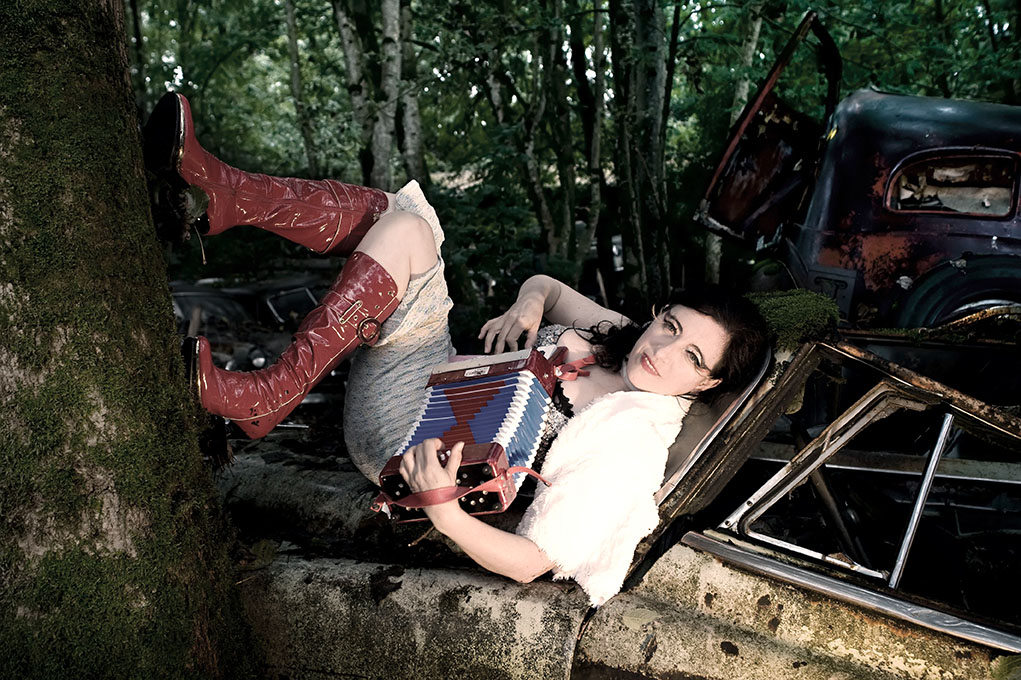Yodelling the old-fashioned way

Traditional Swiss folk music is often performed at conservative political events, but Barbara Betschart, head of Roothuus Gonten, the Centre for Appenzell and Toggenburg Folk Music, dismisses the notion that this is the only place to find it.
“Emancipated, modern people make folk music too”, said BetschartExternal link [link in German]. Folk music in Switzerland is cool right now, in the cities as well as the countryside, but Betschart does not believe that hit records are the same as folk music. “What’s on television these days doesn’t have a lot to do with traditional folk music.”
Music for tourists
Those looking for authentic folk music might want to visit the Säntis region. In Appenzell and Toggenburg in the St. Gallen region, string instruments are still part of folk-music culture – unlike other regions of Switzerland where they have been displaced by accordions and wind instruments.
Appenzell natural yodelling by the Herisau Alpeblueme Yodelling ClubExternal link
This is due to factors such as geographical remoteness and tourism, which dates to the 19th century. Tourists and spa guests wanted traditional music, ensuring its survival to this day.
The same goes for yodelling, or singing without words. “In the Säntis region they have a lead yodeller and a second voice, together with a ‘choir’ that lays down the bass line, always singing the same low notes”, Betschart says. “So anyone who’s at all musical can join in.”
“In central Switzerland that would be unthinkable, because natural yodelling there is so harmonically complicated that you can’t join in unless you’re familiar with it,” she continues. And that, she adds, makes yodelling in the Säntis region much more spontaneous and sociable.
Dulcimers driven out by Catholics, organs destroyed by Protestants
Folk music in the Säntis region is dominated by religion and the confessional separation that followed the Reformation. Each faction jealously made sure their pieces didn’t get into the other region and adopted by the other religion. That is how different regional nuances originated.
In both Catholic Appenzell Inner Rhodes and Protestant Outer Rhodes and Toggenburg, dancing and music were only allowed on a very few feast days during the year. “But on the other hand, everybody went,” says Matthias WeidmannExternal link [link in German], who works at the Centre for Appenzell and Toggenburg Folk Music. “These events were the most important marriage markets at the time.”
Things were not always so decorous. At the beginning of the 16th century the Catholics made the LandjägerExternal link [link in German], a vigilante force, start expelling dulcimer players from Inner Rhodes reputed to be philanderers and drunkards. “They still do, to a certain extent”, Weidmann says with a laugh.
The reformists, on the other hand, destroyed or removed church organs as part of the Zwinglian “iconoclasmExternal link” [link in German]. And this is why a culture of house organsExternal link [link in German], built and played in private houses, emerged in Protestant regions in the 18th century.
Money for music? Ridiculous!
The boom in folk music threatens even original Appenzell music. Weidmann warns that with increasing commercialisation, the repertoire is shrinking. “Everyone wants to hear the hits that they know, so they are all that gets played,” he says.
It’s also typical of commercialisation that fees are rising. These days a young dulcimer soloist can easily charge a thousand francs for a two-hour performance at a wedding.
Weidmann can’t understand it. He tells the story of a US student at the centre whose dissertation about “Swissness” used Appenzell folk music as an example.
“She was a very good violinist, so I took her with me to play at a wedding. Afterwards the bridal couple slipped each musician an envelope containing cash. The student looked at me innocently and asked: ‘Why are they giving us money? They let us play our instruments, and we had a meal as well.’ As an American she found that totally incomprehensible, and in fact so did I. I decided three years ago that my music is no longer for sale. You can only have it as a gift.”
Treasure in the attic
The Roothuus Gonten has set itself the task of preserving the original folk music of the Säntis region.
How exactly does that work? Old sheet music is often found in the attics of houses when they are cleared out after a death. Private bequests of that nature are gifted to the centre, where they are researched and archived. The centre also gives everybody access to the music: it publishes transcriptions on its websiteExternal link [link in German] or in booklets. Betschart says this gives even children with no previous contact with the folk-music tradition the opportunity to learn it.
But the sheet music itself doesn’t just gather dust in the archive: the centre organises regular concerts and “StobedenExternal link” [link in German] – friendly get-togethers with music, dancing and drinks – at which the pieces are actually performed. “Music has to be experienced”, says Betschart.
Weekly performance at the Centre for Appenzell and Toggenburg Folk Music
No girls allowed
What makes archive work so valuable is that Appenzell folk music has always been an oral tradition. Not many people could read music in the past, so they could only learn a piece by hearing it. The centre’s work supplements this oral tradition by creating a historic record of folk music, says Betschart, while living music – like a dialect – continues to develop and change over the generations.
This direct transfer within the family is still a tradition in the Säntis region to this day. In the past, musical knowledge was traditionally handed down from father to son. Girls were excluded, says Betschart. Their function was restricted to providing eye candy in their traditional costumes. Things may be changing, says Betschart, but “in the Säntis region, it’s still true that more men than women play folk music”.
The centre’s tasks include collecting, archiving, research and education. Sheet music, letters, pictures, photos and audio material – most of it from private bequests – are archived, researched and made available to the public. Guided tours, “Stobeten”, concerts and courses (on yodelling, dancing and playing the zither and the violin) are held in order to keep Appenzell folk music alive.
The “Roothuus Gonten” is a foundation of the cantons of Appenzell Inner Rhodes, Appenzell Outer Rhodes and St. Gallen, the Gonten district and the Appenzell not-for-profit association. The centre celebrated its tenth anniversary on 15 May.
Contact the author @SibillaBondolfi on Facebook or Twitter

In compliance with the JTI standards
More: SWI swissinfo.ch certified by the Journalism Trust Initiative












You can find an overview of ongoing debates with our journalists here . Please join us!
If you want to start a conversation about a topic raised in this article or want to report factual errors, email us at english@swissinfo.ch.